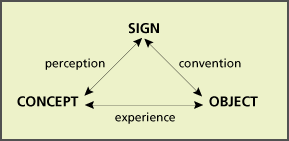The term, which was spelled semeiotics (Greek: σημειωτικός, semeiotikos, an interpreter of signs), was first used in English by Henry Stubbes (1670, p. 75) in a very precise sense to denote the branch of medical science relating to the interpretation of signs. John Locke (1690) used the terms semeiotike and semeiotics in Book 4, Chapter 21 of An Essay Concerning Human Understanding. Here he explains how science can be divided into three parts:

All that can fall within the compass of human understanding, being either, first, the nature of things, as they are in themselves, their relations, and their manner of operation: or, secondly, that which man himself ought to do, as a rational and voluntary agent, for the attainment of any end, especially happiness: or, thirdly, the ways and means whereby the knowledge of both the one and the other of these is attained and communicated; I think science may be divided properly into these three sorts.
—Locke, 1823/1963, p. 174
Locke then elaborates on the nature of this third category, naming it Σημειωτικη (Semeiotike) and explaining it as "the doctrine of signs" in the following terms:
Nor is there any thing to be relied upon in Physick,[2] but an exact knowledge of medicinal physiology (founded on observation, not principles), semeiotics, method of curing, and tried (not excogitated,[3] not commanding) medicines.
—Locke, 1823/1963, 4.21.4, p. 175
Some important semioticians
Charles Sanders Peirce (1839–1914), the founder of the philosophical doctrine known as pragmatism, preferred the terms "semiotic" and "semeiotic." He defined semiosis as "…action, or influence, which is, or involves, a cooperation of three subjects, such as a sign, its object, and its interpretant, this tri-relative influence not being in any way resolvable into actions between pairs." ("Pragmatism", Essential Peirce 2: 411; written 1907). His notion of semiosis evolved throughout his career, beginning with the triadic relation just described, and ending with a system consisting of 59,049 (= 310, or 3 to the 10th power) possible elements and relations. One reason for this high number is that he allowed each interpretant to act as a sign, thereby creating a new signifying relation. Peirce was also a notable logician, and he considered semiotics and logic as facets of a wider theory. For a summary of Peirce's contributions to semiotics, see Liszka (1996).
Charles W. Morris (1901–1979). In his 1938 Foundations of the Theory of Signs, he defined semiotics as grouping the triad syntax, semantics, and pragmatics. Syntax studies the interrelation of the signs, without regard to meaning. Semantics studies the relation between the signs and the objects to which they apply. Pragmatics studies the relation between the sign system and its human (or animal) user. Unlike his mentor George Herbert Mead, Morris was a behaviorist and sympathetic to the Vienna Circle positivism of his colleague Rudolf Carnap. Morris has been accused of misreading Peirce.






























